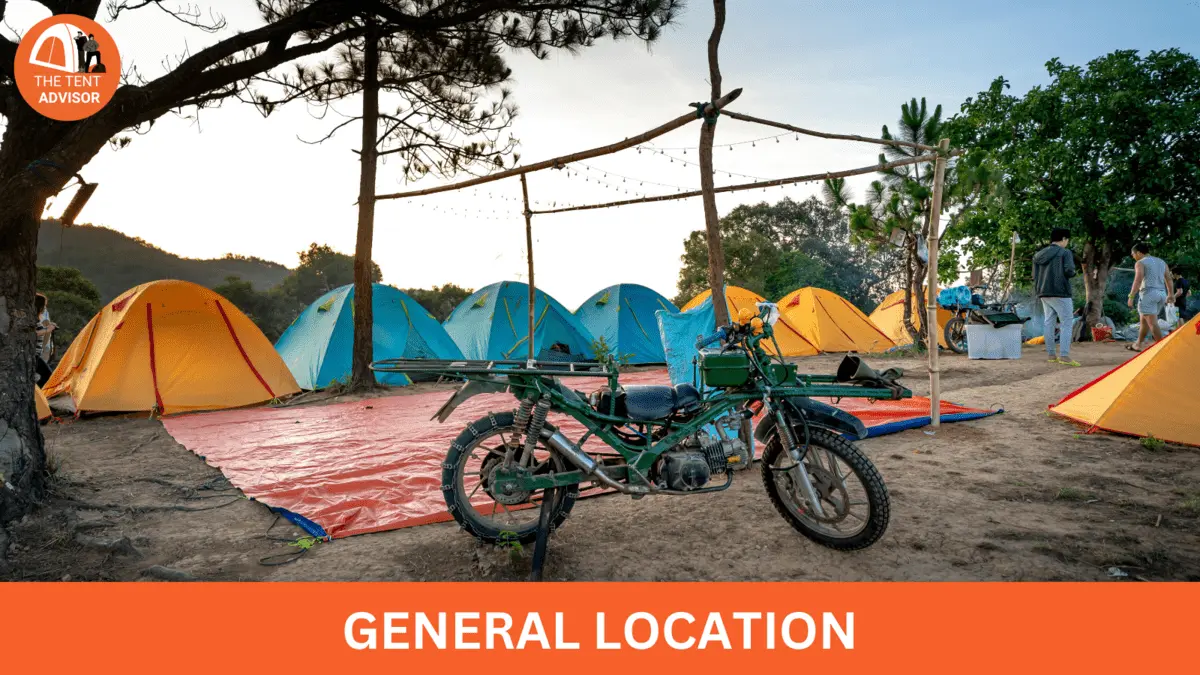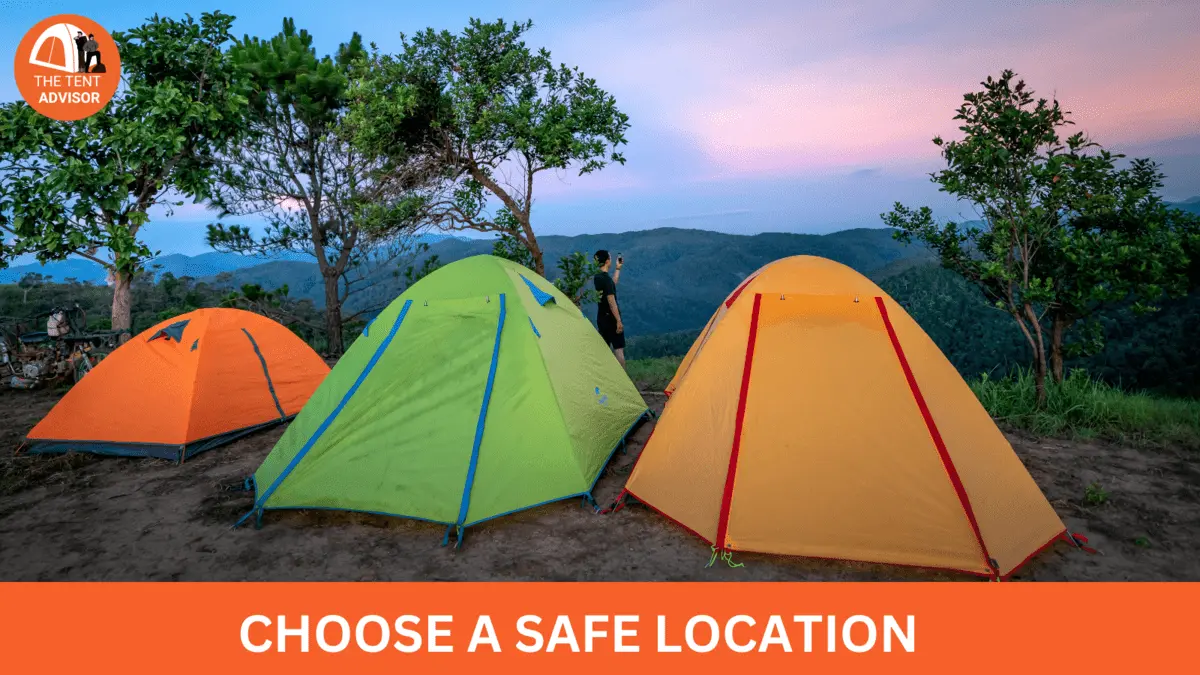Finding the perfect campsite is essential for a peaceful and restful night’s sleep while enjoying the outdoors. Even with the proper shelter and sleeping gear, a low-quality campsite can make it difficult to get a good rest.
This article on How to Select the Perfect Spot for a Tent Campsite aims to share that enchanting experience by highlighting properties that open their grounds to campers, offering opportunities to create unforgettable outdoor memories.
Factors like sleeping on hard ground, dealing with noisy neighbors, or being disturbed by strong winds can significantly impact the quality of your sleep. Therefore, it’s crucial to be intentional and selective when choosing your camping spot.
How to Select the Perfect Spot for Your Tent Campsite: Tips and Advice for an Ideal Camping Experience
The quality of your camping trip can be significantly influenced by your choice. So keep reading How to Select the Perfect Spot for Your Tent Campsite
Proper planning and preparedness will go a long way in ensuring that you avoid some of the common problems, such as tents flooding, falling trees or noisy neighbors.
Regardless of whether it is glamping in an RV, pitching a tent, or cowboy camping under the moonlight, here are some important factors to consider so as to have an awesome camping experience:
Choosing a Safe Location for Tent Camping:
Avoid Danger Zones:
Do not camp in areas prone to rockslides, avalanches, and flash floods.
Seek Privacy:
Stay off the beaten track where there is enough space not to disturb your neighbors or disrupt your peace of mind.
Lightning Safety:
Refrain from camping near isolated trees, mountain tops, high ridges and other locations that offer opportunities for lightning strikes.
Stay Away from Wildlife:
Camp away from animal trails, nests, and habitats.
Avoid Cold and Humid Areas:
Never pitch tents at the bottom of canyons or valleys, the coldest and most humid places on earth.
Insect Safety:
Keep away from breeding places of insects, such as stagnant water, ponds, swamps, and tall meadows full of long grasses that may harbor ticks, among other pests.
Proximity to Resources:
Find a site within reach of firewood supplies and water sources like a river yet far enough not to pollute the water source with human waste.
Finding a General Location:

Plan Ahead:
Begin thinking about location halfway through your day. Using a map, look for places that meet this criteria:
Flat Terrain:
Choose flat areas because they make finding level camping spots much easier
Convenient Resources:
Make sure there is access to wood fire materials and water
Off-Trail Sites:
To avoid bothering other backpackers, choose sites which are off-trail
Avoid Cold and Humid Valleys:
Avoid camping at the bottoms of these valleys, where it tends to be colder and more damp in nature.
Wildlife Precautions:
Camp elsewhere instead if it’s an area being used by animals within their vicinity
Natural Hazard Safety:
Don’t enter natural hazard zones such as avalanche paths, floodplains or severe weather risk regions.
Insect-Free Zones:
Ensure that you are far away from insect breeding grounds, such as saturated meadows or stillwaters
Look for Level Ground.
This is important to your camp’s comfort. While there is some tolerance for slope in a hammock, tents and tarps are best erected on level ground.
If you don’t have a perfectly horizontal spot, think about how you will sleep on the incline. For example, raising your feet after hiking can help with swelling, while propping up your head may relieve congestion during allergy season.
Check Your Campsite’s Drainage
Proper drainage is essential for tents and cowboy camping. Avoid campsites where water runs towards you. In case of rain, dig a small trench/moat around your tent to divert water away from it and prevent flooding into it. This is particularly necessary if camping on a tent pad that might collect water.
Choose Your Door Orientation
Look at where other campers are set up by the orientation of doors in shelters near them. Positioning your tent or campervan door to face away from neighboring sites can provide added privacy.
For families who go tenting with their children, aligning the doors of both tents makes supervision easier. Moving the door away from noise or using trees as buffer zones in an RV park enhances privacy and convenience.
Make the Most of Sun and Shade
In cooler seasons, orient your tent to catch the morning sun for warmth. During summer, look for shaded spots under trees or rock outcroppings to stay cool without getting burnt by direct sunshine.
Avoid camping close to places with many people, like toilets and water points in established campsites. This can make you experience unnecessary noise and interference.
Fun Components For Children
To Enjoy When Camping Select a campsite with fun elements for kids, like rocks, trees, or creeks nearby. Go through the campsite’s photos, reviews or maps to identify child-friendly features.
Ensure Trees Are Not Sick
Check that the trees around your campsite are healthy. Do not go camping near dead or rotted trees that could fall over. For hammock users, choose strong live trees for hanging.
Be Aware Of Sharp
Before setting up your tent, clear, sharp things such as stones and pinecones from underneath it; this will prevent discomfort and minimize the chances of damaging sleep pads.
200-Foot Rule For Campsites
In areas without designated sites, stay at least 200 feet away from the source of water, trailhead and waste disposal area to preserve ecology and not disturb hikers.
Do Not Forget to Leave No Trace
Don’t bring extra environmental impact by selecting already used campsites and pitching tents on durable surfaces; carry out all waste materials after yourself without cutting any plants within this site’s vicinity according to Leave No Trace Seven Principles.
Frequently Asked Questions: How to Select the Perfect Spot for a Tent Campsite
- When choosing a tent site, what should be considered?
When selecting a tent site, consider the following factors:
- Shade and Protection: Look for natural features like rock outcroppings or tall trees that provide shade and protection from wind.
- Flat Ground: Ensure the site is level and free of sticks, rocks, and stumps to ensure comfort and prevent damage to your tent.
- Ground Condition: Choose a site with durable, stable ground rather than wet, muddy, or excessively uneven areas.
- Shelter from Elements: Select a spot that offers some natural shelter from wind and potential weather conditions.
- Proximity to Water: Consider the site’s distance from water sources to avoid issues with flooding and contamination.
- What are the best places to pitch a tent?
For an optimal camping experience, consider these factors when choosing a location:
- Discreet Location: Pick a site away from roads, paths, and houses to maintain privacy.
- Flat Land: Ensure the site is level for comfort and stability.
- Ground Condition: Choose a suitable location, avoiding areas with rocks or uneven terrain.
- Sheltered from Elements: Look for natural features that offer protection from wind and weather.
- Proximity to Water: Consider how close the site is to a water source, balancing convenience with the risk of flooding.
- Where should you pitch a tent on a campsite?
To pitch your tent effectively:
- Find Flat, Level Ground: Look for a flat, level area free of sticks, stumps, and debris. Clear away any removable objects if needed, but replace them when you leave.
- Avoid Low Spots: Steer clear of depressions that could collect water in case of rain.
- Consider the Wind: Set up your tent in a location sheltered from prevailing winds, if possible.
- What is the golden rule of camping?
The golden rule of camping is to leave no trace. This means always going to the campsite in better condition than you found it. This includes packing out all trash, minimizing environmental impact, and ensuring the area is clean before you leave.
- What are the four main types of tents?
The four main types of tents are:
- A-Frame Tents: Traditional style with a simple, triangular design.
- Pyramid Tents: Single-pointed tents that offer a more compact and stable structure.
- Hoop Tents: Feature curved poles that create a rounded shape for stability and space.
- Dome Tents: Popular design with a geodesic structure for added strength and headroom.
How to Select the Perfect Spot for Your Tent Campsite-Final Recommendations
The perfect spot for your tent campsite is so important for a safe and enjoyable outdoor experience. Consider factors such as location, terrain, and potential hazards to ensure a comfortable and memorable camping trip. Always prioritize safety, comfort, and environmental respect when choosing your campsite.
After reading this comprehensive guide on How to Select the Perfect Spot for Your Tent Campsite, finding a perfect camping site is no longer a hassle. Now, enjoy a memorable camping trip!
You may also like

